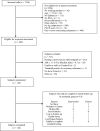Effects of a home-based walking intervention on mobility and quality of life in people with diabetes and peripheral arterial disease: a randomized controlled trial
- PMID: 21873560
- PMCID: PMC3177730
- DOI: 10.2337/dc10-2399
Effects of a home-based walking intervention on mobility and quality of life in people with diabetes and peripheral arterial disease: a randomized controlled trial
Abstract
Objective: Determine the efficacy of a home-based walking intervention to improve walking ability and quality of life in people with diabetes and peripheral arterial disease (PAD).
Research design and methods: We conducted a randomized, controlled, single-blind trial within university-affiliated clinics in our local community. We randomized 145 participants (45 women) with diabetes and PAD to our intervention--a 6-month behavioral intervention targeting levels of readiness to engage in routine walking for exercise--versus attention control. Our primary outcome was 6-month change in maximal treadmill walking distance. Secondary outcomes included 3-month change in maximal walking distance, lower limb function (i.e., walking impairment scores), quality of life (Medical Outcomes Short Form Survey), exercise behaviors, depressive symptoms, and self-efficacy at 3 and 6 months.
Results: The mean age of participants was 66.5 (SD 10.1) years. Intervention and control groups did not differ significantly in 6-month change in maximal treadmill walking distance (average [SE] 24.5 [19.6] meters vs. 39.2 [19.6] meters; P = 0.60). Among secondary outcomes, for the intervention and control groups, respectively, average walking speed scores increased by 5.7 [2.2] units and decreased by 1.9 [2.8] units (P = 0.03); the mental health quality of life subscale score increased by 3.2 [1.5] and decreased by 2.4 [1.5] units (P = 0.01).
Conclusions: A home-based walking intervention did not improve walking distance but did improve walking speed and quality of life in people with diabetes and PAD. Clinicians should consider recommending home-based walking therapy for such patients.
Trial registration: ClinicalTrials.gov NCT00611988.
References
-
- Hirsch AT, Criqui MH, Treat-Jacobson D, et al. Peripheral arterial disease detection, awareness, and treatment in primary care. JAMA 2001;286:1317–1324 - PubMed
-
- Collins TC, Petersen NJ, Suarez-Almazor M. Peripheral arterial disease symptom subtype and walking impairment. Vasc Med 2005;10:177–183 - PubMed
-
- McDermott MM, Liu K, Greenland P, et al. Functional decline in peripheral arterial disease: associations with the ankle brachial index and leg symptoms. JAMA 2004;292:453–461 - PubMed
-
- Norgren L, Hiatt WR, Dormandy JA, Nehler MR, Harris KA, Fowkes FG. Inter-Society Consensus for the Management of Peripheral Arterial Disease (TASC II). J Vasc Surg 2007;45(Suppl. S):S5-S67 - PubMed
-
- Mohler ER, 3rd, Hiatt WR, Creager MA. Cholesterol reduction with atorvastatin improves walking distance in patients with peripheral arterial disease. Circulation 2003;108:1481–1486 - PubMed


